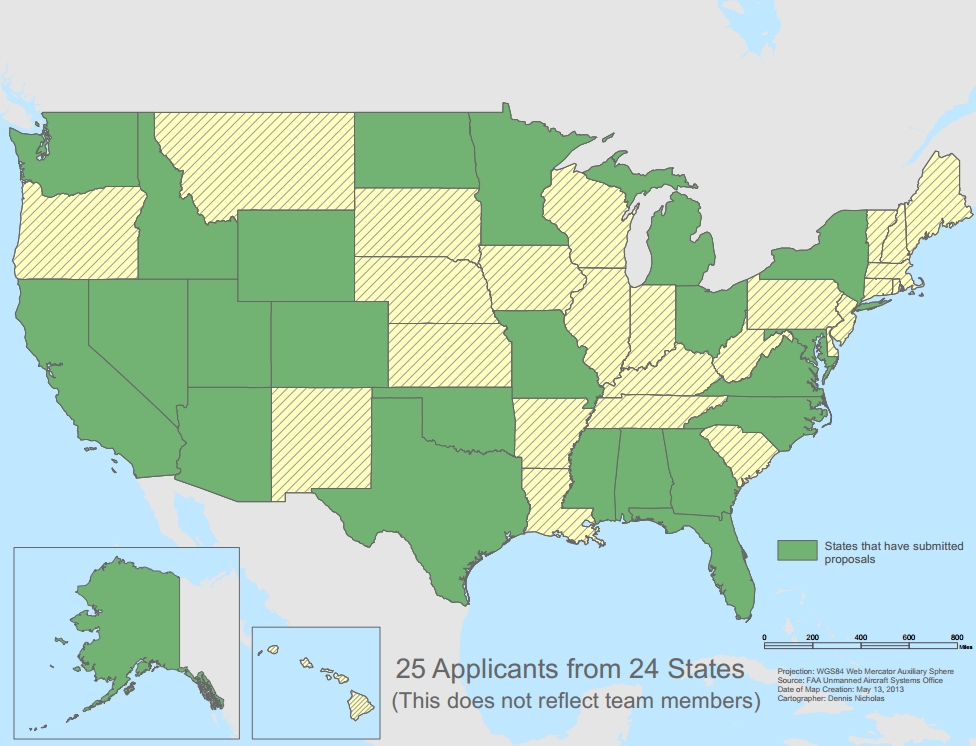
(KCPW News) Back in February of 2012, Congress and President Obama authorized the Federal Aviation Administration, or FAA, to choose six test sites for commercial drone use. In December, the FAA is expected to announce which locations they’ve selected.
Utah is one of 24 states vying for this potentially lucrative deal. The state has proposed four sites around the state, including Green River, Milford, Delta, and on the private grounds of aerospace company Alliant Techsystems’ testing site near Promintory Point.
There are a multitude of potential applications for unmanned aircraft. Whether it’s spraying crops or surveying land during wildfires, it seems the drone business is on the verge of a commercial eruption.
That’s why Marshall Wright of the Governor’s Office of Economic Development, or GOED, has been pushing hard for Utah to become one of six states in the country selected to host a commercial drone testing site.
Wright, who prefers “unmanned aircraft system” over the more colloquial term “drone,” says the GOED has performed independent research indicating potential economic benefits to an expanded commercialization of unmanned aircraft systems.
“If the commercialization of unmanned aircraft systems is allowed, and that industry could grow, we estimate that over the next ten years the impact to Utah would be directly about 10,000 employees,” he says.
While drones show a lot of promise for civilian and industry use, most discussion of this emerging technology starts with the negative perceptions surrounding military use or privacy concerns. In the case of commercial use, however, Wright personally feels such negativity is misplaced.
“That’s one of the rationales for having these test sites,” Wright explains. “One would hope that we allow the test sites to help us develop and understand what kind of regulations and requirements are needed such that we do not have ineffective laws which restrict economic development.”
To assuage privacy concerns, Wright says the Aerospace States Association has worked with various civil liberties organizations. One such organization is the American Civil Liberties Union, or ACLU.
Marina Lowe of ACLU Utah sees a mix of positive and negative possibilities for unmanned aircraft, but she says getting our legal framework ahead of the technology is key.
“I think the real point is, with any sort of new technology, we see that our privacy rights are a little bit lagging,” Lowe says. “They’re always trying to catch up to the latest technology that’s developing. So that’s why it’s really incumbent on our lawmakers and on Utahns to press for the protections to be put into law so that, as we move forward with these technologies, we’re not leaving our rights behind.”
The FAA has outlined privacy requirements for the new drone testing sites, but Jennifer Lynch of the Electronic Frontier Foundation says they may not go far enough.
In comments submitted to the FAA, Lynch says the FAA needs to address privacy issues with the same vigor that they address safety issues, saying, “Just as vague safety regulations for drones could result in damage to life or property, vague privacy measures could harm civil liberties.”
But as the federal government and the states come to terms with the legal issues posed by commercial drone use, Wright says the Utah economy stands to benefit from the development of unmanned aircraft systems—even if Utah loses out on the FAA’s testing site giveaway.
“Over the next ten years, the total industry could be $100 billion. What it could mean to Utah would be in the order of maybe $10 billion to $20 billion-worth of business over the next ten years,” Wright says. “So we will get some benefit. No matter what happens, it’ll grow. If our site is here in Utah, we will get even more of a benefit.”
To date, the FAA bars unmanned aircraft for commercial use in the United States.
How do you feel about this topic?
Is there anything else you think we should know? We'd like to hear your thoughts. Send us your feedback using the form below.




